
Introduction
The global economy is undergoing significant shifts as the United States intensifies its tariff policies, affecting key industries such as automotive manufacturing and energy production. With increasing trade restrictions on vehicle imports from Mexico and Canada and growing energy demands between India and the US, businesses and consumers alike are bracing for potential disruptions.
This article explores how these trade tensions are reshaping the automotive and energy markets, examining their impact on manufacturers, global supply chains, and economic growth.
The US Tariff Strategy: Key Changes
The US government has proposed or implemented new tariffs targeting automobile imports and energy exports, citing the need to protect domestic industries and national security interests.
Automotive Tariffs: A Challenge for North America
The US administration has announced higher tariffs on vehicle imports, particularly from Mexico and Canada, two of the largest suppliers of automotive parts and fully assembled vehicles to the American market.
Key Reasons for These Tariffs
1. Protecting US Manufacturing – The government aims to encourage domestic production by making foreign-made vehicles more expensive.
2. Addressing Trade Imbalances – US officials argue that Mexico and Canada benefit disproportionately from trade agreements like the USMCA (United States-Mexico-Canada Agreement).
3. Job Creation Goals – Tariffs are intended to bring back manufacturing jobs to the US auto sector.
Potential Consequences for the Auto Industry
However, automakers and industry experts have raised serious concerns, warning that these tariffs could do more harm than good:
• Increased Vehicle Prices – Consumers may have to pay thousands of dollars more for new cars as automakers pass on the increased costs.
• Supply Chain Disruptions – The North American auto industry is highly integrated, and tariffs could delay production and parts availability.
• Job Losses Instead of Job Creation – Rather than strengthening US employment, higher costs could force automakers to cut jobs or relocate production outside of North America.
Ford’s CEO Speaks Out
Ford CEO Jim Farley recently warned that the tariffs could “blow a hole” in the US auto industry, making manufacturing significantly more expensive and less competitive.
“These tariffs will increase costs for American consumers and disrupt the highly efficient supply chains we’ve built over decades.” – Jim Farley
Other automakers, including General Motors, Toyota, and Volkswagen, have echoed similar concerns, emphasizing that a globalized supply chain is essential for cost efficiency and product innovation.
US Energy Policies and India’s Growing Demand
India’s Push for More US Energy Imports
While tariffs are creating barriers in the automotive sector, the energy industry is witnessing greater cooperation between the US and India. Ahead of a scheduled meeting between Prime Minister Narendra Modi and President Joe Biden, India has expressed interest in boosting energy imports from the US, including liquefied natural gas (LNG), crude oil, and renewable energy technologies.
Why India Wants More US Energy
• Diversifying Energy Sources – India, one of the world’s fastest-growing economies, seeks to reduce dependence on the Middle East by expanding its energy partnerships.
• Rising Industrial Demand – India’s manufacturing and infrastructure sectors require consistent energy supply, making long-term contracts with US energy providers attractive.
• Strategic Geopolitical Moves – Strengthening trade ties with the US helps India counterbalance China’s growing influence in global energy markets.
US Energy Companies’ Perspective
For US energy companies, India represents a lucrative export market as domestic energy demand remains steady. Major American firms, including ExxonMobil, Chevron, and Cheniere Energy, are already expanding their presence in India, viewing it as a long-term growth opportunity.
Potential Benefits for Both Countries
• For the US – Increased exports to India can stabilize energy prices, support domestic job growth, and reduce trade deficits.
• For India – A reliable energy partnership with the US ensures stable supply chains and competitive pricing compared to traditional Middle Eastern suppliers.
Challenges and Risks
However, trade tensions and geopolitical uncertainties could still create challenges:
• Price Fluctuations – If the US imposes new energy tariffs or restrictions, India may seek alternatives, such as Russia or Middle Eastern suppliers.
• Infrastructure Bottlenecks – India must invest in new LNG terminals and transport infrastructure to fully capitalize on US energy imports.
• Shifting Trade Policies – Future US administrations could revise export policies, affecting long-term energy agreements.
Global Trade Outlook: What’s Next?
Short-Term Industry Impact
• Automotive Industry – Tariffs could increase costs, disrupt supply chains, and slow production, potentially leading to fewer car options and higher prices for consumers.
• Energy Trade – While the US-India energy relationship is growing, trade uncertainties may impact pricing and future investment strategies.
Long-Term Economic Consequences
If current policies persist, global trade may realign in significant ways:
• Automakers could relocate manufacturing to non-tariff countries, shifting jobs away from the US.
• India may form alternative energy partnerships with Russia or Middle Eastern nations to counteract US pricing volatility.
• Other countries could introduce retaliatory tariffs, further escalating global trade tensions.
The US government’s tariff policies are causing major shifts in the global economy, with automakers and energy companies facing distinct challenges and opportunities. While the automotive sector struggles with rising costs and supply chain disruptions, the energy industry is seeing potential growth through expanding US-India trade relations.
Key Takeaways
• US tariffs on vehicle imports could hurt the auto industry, raising prices and disrupting supply chains.
• Ford and other automakers warn that tariffs may backfire, leading to job losses and production delays.
• India is looking to increase US energy imports, strengthening economic ties and diversifying its energy sources.
• The long-term impact depends on future trade negotiations, with both risks and opportunities for global markets.
As businesses and governments navigate this complex landscape, it remains crucial to balance trade protectionism with economic stability, ensuring that global industries remain competitive and sustainable.